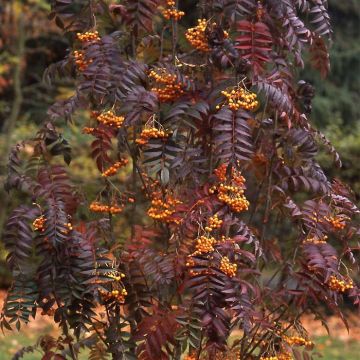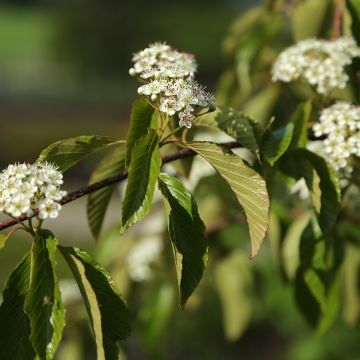

Sorbus commixta Olympic Flame
Sorbus commixta Olympic Flame
Sorbus commixta var. ulleungensis Dodong (Olympic Flame)
rowan
Special offer!
Receive a €20 voucher for any order over €90 (excluding delivery costs, credit notes, and plastic-free options)!
1- Add your favorite plants to your cart.
2- Once you have reached €90, confirm your order (you can even choose the delivery date!).
3- As soon as your order is shipped, you will receive an email containing your voucher code, valid for 3 months (90 days).
Your voucher is unique and can only be used once, for any order with a minimum value of €20, excluding delivery costs.
Can be combined with other current offers, non-divisible and non-refundable.
Home or relay delivery (depending on size and destination)
Schedule delivery date,
and select date in basket
This plant carries a 24 months recovery warranty
More information
We guarantee the quality of our plants for a full growing cycle, and will replace at our expense any plant that fails to recover under normal climatic and planting conditions.
Would this plant suit my garden?
Set up your Plantfit profile →
Description
Sorbus commixta Olympic Flame or 'Dodong' is a variety of Japanese Mountain Ash with moderate growth, which forms a small tree or a large bush with multiple trunks. It blooms in spring, producing clusters of cream-white flowers that later develop into very decorative orange-red fruits. Its deciduous leaves, composed of numerous elongated, beautiful glossy dark green leaflets, offer a magical spectacle in autumn when they blaze with vibrant colours. Very hardy and adaptable to most soils, this beautiful Mountain Ash is an excellent choice for small urban gardens, especially since it tolerates pollution well.
The Mountain Ash belongs to the large family of Rosaceae, which includes more than 5000 species, including most of our temperate climate fruit trees, as well as wild plants in our countryside, and of course, numerous ornamental genera, such as Amelanchiers, countless Prunus, and the queen of flowers, the rose. The genus Sorbus comprises about a hundred species of shrubs or trees, with compound leaves (the Mountain Ashes) or simple leaves (the Whitebeams).
Sorbus commixta, the Japanese Mountain Ash, grows naturally in the Far East: central and eastern China, Korea, Japan, and as far as the Russian island of Sakhalin, off the coast of Siberia. It is found in forests and on mountain slopes, in the form of a small tree 7 to 10 m tall, sometimes a little taller. It develops a rounded crown, carried by a trunk with brown-grey bark. Its compound leaves take on beautiful red or dark purple colours in autumn before falling. Its late spring flowering in clusters of 9 to 15 cm consists of small cream-white flowers, 6 to 10 mm in diameter, which then give way to fruits 7-8 mm in diameter, orange to red in autumn.
'Dodong' is a Swedish selection made by Tor Nitzelius from seeds collected in 1976 on the South Korean island of Ullung-do, and whose port is called Dodong. This Mountain Ash is also known as 'Olympic Flame', because of its autumnal appearance reminiscent of the Olympic flame, but some consider it a distinct variety. Dodong has a conical to pyramidal habit, which can slightly widen with age. In 10 years of planting, it will reach an average height of 6 m with a width of 3 m. At maturity, it can grow up to 8-10 m in height with a spread of 4-6 m. Its foliage is particularly ornamental, consisting of odd-pinnate leaves composed of 15 to 17 leaflets. Measuring 4 to 8 cm in length, they are very slender with a long pointed tip, giving them a graceful appearance reminiscent of certain ferns. When they emerge in spring, the young leaves are bronze-coloured before turning fairly dark green and slightly glossy. In autumn, they blaze, changing from dark yellow to flamboyant orange and then intense red, transforming the plant's silhouette into an evocation of the Olympic torch.
The flowering is the second highlight of this variety, when large clusters of 8 to 12 cm in diameter, composed of white flowers, bloom in May and June. These light inflorescences are particularly enhanced by the darker foliage and make the plant very attractive in spring. After fertilisation, the flowers develop into pea-sized, pear-shaped fruits. The large clusters of orange-red fruits create a superb contrast against the green foliage in late summer and remain on the plant for a long time, at least as long as the birds spare them.
The 'Dodong' Mountain Ash is the ideal plant for beginners in the garden, easy to grow, adapting to most well-drained soils, very hardy, and requiring only sun or light shade. This variety is also particularly generous, offering ornamental flowering and fruiting, as well as some of the most vibrant autumn colours. Plant it as a specimen on a lawn, as it deserves, or incorporate it into a border alongside other equally accommodating plants. Plant a Weigela florida 'Alexandra' at its base, whose dark purple foliage will create a magnificent contrast with Dodong's foliage throughout the growing season. In addition, its pink flowering will perfectly complement that of your Mountain Ash in May. Also, plant a Philadelphus coronarius 'Aureus' in the shade of the Mountain Ash. This Mock Orange with golden foliage will add an extra colourful touch, and its highly fragrant spring flowering will surely charm you. And to flower your summer, nothing beats an Indian Lilac, or Lagerstroemia, whose clusters of flowers will illuminate your scene in white, pink, red, purple, or mauve, depending on the variety.
Report an error about the product description
Plant habit
Flowering
Foliage
Botanical data
Sorbus
commixta var. ulleungensis
Dodong (Olympic Flame)
Rosaceae
rowan
Sorbus 'Dodong', Sorbus commixta 'Dodong', Sorbus 'Olympic Flame'
Cultivar or hybrid
Other Sorbus - Mountain Ash
View all →Planting and care
Sorbus commixta 'Dodong' is best planted in autumn in any type of soil, preferably moist (but tolerates dryness), slightly acidic to neutral (also tolerates limestone). Not demanding, it adapts to loamy, clayey or sandy soils. Dig a planting hole with sides of 60 to 80 cm and add some compost to the bottom if the soil is poor. Soak the container in a bucket to thoroughly saturate the root ball before placing it in the planting hole. Fill in and water abundantly; monitor watering in the first few years to allow the tree to establish well.
It will thrive in sunny exposure and tolerate partial shade, and has no specific requirements. You can remove dead wood, but due to the slow growth of this tree, pruning is usually not necessary.
Mites, aphids, and scale insects are the main enemies of the mountain ash. Powdery mildew and sooty mould, of cryptogamic origin, are diseases that can also affect this tree.
Planting period
Intended location
Care
This item has not been reviewed yet - be the first to leave a review about it.
Haven't found what you were looking for?
Hardiness is the lowest winter temperature a plant can endure without suffering serious damage or even dying. However, hardiness is affected by location (a sheltered area, such as a patio), protection (winter cover) and soil type (hardiness is improved by well-drained soil).

Photo Sharing Terms & Conditions
In order to encourage gardeners to interact and share their experiences, Promesse de fleurs offers various media enabling content to be uploaded onto its Site - in particular via the ‘Photo sharing’ module.
The User agrees to refrain from:
- Posting any content that is illegal, prejudicial, insulting, racist, inciteful to hatred, revisionist, contrary to public decency, that infringes on privacy or on the privacy rights of third parties, in particular the publicity rights of persons and goods, intellectual property rights, or the right to privacy.
- Submitting content on behalf of a third party;
- Impersonate the identity of a third party and/or publish any personal information about a third party;
In general, the User undertakes to refrain from any unethical behaviour.
All Content (in particular text, comments, files, images, photos, videos, creative works, etc.), which may be subject to property or intellectual property rights, image or other private rights, shall remain the property of the User, subject to the limited rights granted by the terms of the licence granted by Promesse de fleurs as stated below. Users are at liberty to publish or not to publish such Content on the Site, notably via the ‘Photo Sharing’ facility, and accept that this Content shall be made public and freely accessible, notably on the Internet.
Users further acknowledge, undertake to have ,and guarantee that they hold all necessary rights and permissions to publish such material on the Site, in particular with regard to the legislation in force pertaining to any privacy, property, intellectual property, image, or contractual rights, or rights of any other nature. By publishing such Content on the Site, Users acknowledge accepting full liability as publishers of the Content within the meaning of the law, and grant Promesse de fleurs, free of charge, an inclusive, worldwide licence for the said Content for the entire duration of its publication, including all reproduction, representation, up/downloading, displaying, performing, transmission, and storage rights.
Users also grant permission for their name to be linked to the Content and accept that this link may not always be made available.
By engaging in posting material, Users consent to their Content becoming automatically accessible on the Internet, in particular on other sites and/or blogs and/or web pages of the Promesse de fleurs site, including in particular social pages and the Promesse de fleurs catalogue.
Users may secure the removal of entrusted content free of charge by issuing a simple request via our contact form.
The flowering period indicated on our website applies to countries and regions located in USDA zone 8 (France, the United Kingdom, Ireland, the Netherlands, etc.)
It will vary according to where you live:
- In zones 9 to 10 (Italy, Spain, Greece, etc.), flowering will occur about 2 to 4 weeks earlier.
- In zones 6 to 7 (Germany, Poland, Slovenia, and lower mountainous regions), flowering will be delayed by 2 to 3 weeks.
- In zone 5 (Central Europe, Scandinavia), blooming will be delayed by 3 to 5 weeks.
In temperate climates, pruning of spring-flowering shrubs (forsythia, spireas, etc.) should be done just after flowering.
Pruning of summer-flowering shrubs (Indian Lilac, Perovskia, etc.) can be done in winter or spring.
In cold regions as well as with frost-sensitive plants, avoid pruning too early when severe frosts may still occur.
The planting period indicated on our website applies to countries and regions located in USDA zone 8 (France, United Kingdom, Ireland, Netherlands).
It will vary according to where you live:
- In Mediterranean zones (Marseille, Madrid, Milan, etc.), autumn and winter are the best planting periods.
- In continental zones (Strasbourg, Munich, Vienna, etc.), delay planting by 2 to 3 weeks in spring and bring it forward by 2 to 4 weeks in autumn.
- In mountainous regions (the Alps, Pyrenees, Carpathians, etc.), it is best to plant in late spring (May-June) or late summer (August-September).
The harvesting period indicated on our website applies to countries and regions in USDA zone 8 (France, England, Ireland, the Netherlands).
In colder areas (Scandinavia, Poland, Austria...) fruit and vegetable harvests are likely to be delayed by 3-4 weeks.
In warmer areas (Italy, Spain, Greece, etc.), harvesting will probably take place earlier, depending on weather conditions.
The sowing periods indicated on our website apply to countries and regions within USDA Zone 8 (France, UK, Ireland, Netherlands).
In colder areas (Scandinavia, Poland, Austria...), delay any outdoor sowing by 3-4 weeks, or sow under glass.
In warmer climes (Italy, Spain, Greece, etc.), bring outdoor sowing forward by a few weeks.










































